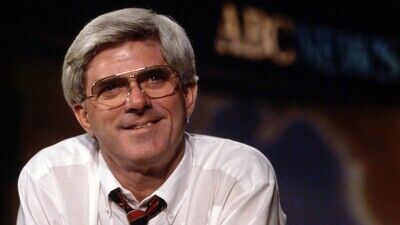Born in Cleveland, Ohio, on December 21, 1935, Donahue’s first brush with the broadcasting industry came after his junior year at Notre Dame, where he was a business major when he took a summer job at WNDU, a local station owned by the university. After graduation, he began working as a replacement announce on another local TV/radio outlet before landing jobs as a program director at a Michigan station and at WHIO-AM-TV in Dayton, where he interviewed the likes of Jimmy Hoffa and hosted a radio talk show called “Conversation Piece.” Although his frustrations at being unable to crack into a national job caused him to briefly leave broadcasting entirely to work for a trading stamp company, he returned to it in 1967 with a new Dayton-based morning television talk show entitled “The Phil Donahue Show” that would go on to change television history forever.
Then, as now, most of the major talk shows were broadcast out of either New York or Los Angeles because that was where the personalities that one hoped to see sitting on the couch tended to congregate. Dayton, on the other hand, has never been known for being a media hotspot, and getting those personalities to hop a plane to Ohio to appear on a talk show to promote their new movies was simply not going to happen. Recognizing this, Donahue ended up rejiggering the format in ways that would allow him to make the best use of his limited resources. Instead of struggling to recruit the standard two or three guests per show, each one talking about their own particular thing, he would spend each episode focusing on a single guest and topic. These topics would mostly eschew the standard talk show froth to tackle more serious-minded subjects that reflected the increasingly tumultuous times. Perhaps most significantly, he transformed his studio audiences from passive to active participants, including them in the proceedings by going out into their seats to delve into their thoughts on the subject at hand or have them pose their own questions to the guests.
From the very first episode (which featured Madalyn Murray O’Hair, the famous atheist who had just helped to lead the case that led to the Supreme Court barring prayer in schools), the show was a hotbed of controversy. It dealt with such formerly verboten topics as premarital sex, prison reform, homosexuality, and other social, political, and cultural issues of the day. The show was also an instant success, and in 1969, it was re-launched in national syndication. By 1971, it could be seen on 44 stations throughout the country, and in 1974, the show moved its base of operations to Chicago, where it was renamed “Donahue” and produced out of the studio facilities at WGN and would soon be taken over by the emerging syndicator Multimedia Program Productions.

